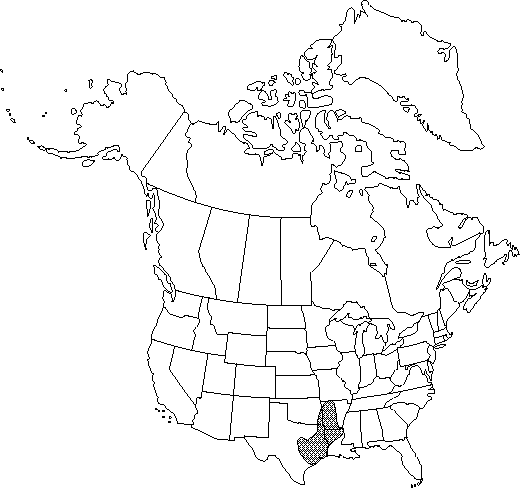Aristolochia reticulata
Trans. Amer. Philos. Soc., n.s. 5: 162. 1835.
Herbs, erect to sprawling, to 0.4 m. Young stem ribbed, hispid. Leaves: petiole 0.1-0.8 cm. Leaf blade ovate, 7-12 × 3-6 cm, base sagittate to auriculate, sinus depth 0.5-1.2 cm, apex obtuse or rounded; surfaces abaxially hispid; venation palmate-pinnate. Inflorescences from base of stem, racemes; peduncle bracteolate, 0.5-0.7 cm; bracteoles ovate-lanceolate, to 2 mm. Flowers: calyx brown-purple, bent; utricle pendent, pear-shaped to somewhat globose, 0.4-0.5 cm; syrinx indistinct or absent, oblique; tube horizontal, funnel-shaped, 5-7 × 1-3 cm; annulus absent; limb purplish brown, 3-lobed, lobes 0.4-0.6 × 0.5 cm, glabrous; gynostemium 3-lobed, globose, 5-10 mm; anthers 6; ovary 6-locular, 0.5-0.7 cm. Capsule globose, 1.2 × 1-3 cm, dehiscence basipetal; valves 6; septa entire, not attached to valves. Seeds rounded, ovate, 0.3 × 0.3 cm. 2n = 28.
Phenology: Flowering late spring–summer.
Habitat: Moist, sandy soils
Elevation: 30-600 m
Distribution

Ark., La., Okla., Tex.
Discussion
The dried rhizome of Aristolochia reticulata is sometimes sold as serpentary. It is used as a tonic to calm the stomach, promote urination, and increase perspiration. The active ingredient is aristolochic acid, a potent gastric irritant that, in large doses, can cause respiratory paralysis. The leaves are eaten by larvae of the eastern pipe-vine swallowtail butterfly, Battus philenor philenor (Linnaeus) (W. H. Howe 1975).
Selected References
None.
